Grandstream Networks GXV317X IP Multimedia Phone User Manual
Grandstream Networks, Inc. IP Multimedia Phone
Contents
- 1. YZZGXV317X_user manual part 1-rev1
- 2. YZZGXV317X_user manual part 2-rev1
YZZGXV317X_user manual part 1-rev1

Grandstream Networks, Inc.
GXV3175
Touchscreen IP Multimedia Phone
Grandstream Networks, Inc. GXV3175 USER MANUAL
FIRMWARE VERSION 1.0.0.32 Updated : 11/2010

Grandstream Networks, Inc. GXV3175 USER MANUAL
FIRMWARE VERSION 1.0.0.32 Updated : 11/2010
WELCOME
Thank you for purchasing Grandstream GXV3175 Touchscreen IP Multimedia Phone. The GXV3175 IP
Multimedia Phone gives you a brand new experience to enjoy the 7” user-friendly touchscreen, plug-and-
play access to free real-time video/voice calling with always-on Internet web entertainment and social
networking applications. With video calling - part of the revolution called Visual Communicating – get
ready to enhance personal and business relationships by hearing and seeing the person with whom you
are communicating.
This user manual is designed to help you understand how to configure and manage the GXV3175
Touchscreen IP Multimedia Phone. Beside demonstrating how to install this unit with ease, this manual
will explain how to fully utilize all the phone’s voice and video calling features like conference calling,
direct IP calling as well as explore all the built-in feature-rich multimedia applications such as YouTube,
Google Voice, Flickr and more.
GXV3175 OVERVIEW
The GXV3175 is a next generation SIP-based touchscreen IP Multimedia Phone that supports a high
quality selection of audio codecs and is compatible with the H.264/H.263/H.263+ video codec. The
advanced telephony and video features, interoperability with 3rd party SIP products and ease of use make
it an ideal IP multimedia device for both enterprise and consumer users.
Once the GXV3175 is plugged into the broadband Internet connection, you can begin to make video calls
using the 7” LCD display and enjoy other features of the multimedia phone including:
• Integrated web browser for one-touch access to personalized RSS feeds of real-time online
information services (news updates, stock updates, weather forecasts, recipes and etc.)
• Access to thousands of Internet radio stations and popular online music networks such as Last.fm.
• Access to social networking sites like Google Voice and web photo album like Yahoo Flickr,
Photobucket and phanfare
• Access to streaming Internet entertainments sites like YouTube and Movie Trailer
• Access to build-in games like Gottet, Simsu, Picture Matching and QChecker
• Digital Photo Frame
• Full duplex speakerphone
• Ability to project video onto TV for larger picture

Grandstream Networks, Inc. GXV3175 USER MANUAL Page 3 of 68
FIRMWARE VERSION 1.0.0.32 Updated : 11/2010
CAUTION: Changes or modifications to this product not expressly approved by Grandstream, or operation of
this product in any way other than as detailed by this User Manual, could void your manufacturer warranty.
• This document is subject to change without notice. The latest electronic version of this user manual is
available for download here:
http://www.grandstream.com/support/gxv_series_phone/gxv3175/documents/gxv3175_usermanual_englis
h.pdf
• Reproduction or transmittal of the entire or any part, in any form or by any means, electronic or print, for
any purpose without the express written permission of Grandstream Networks, Inc. is not permitted.

Grandstream Networks, Inc. GXV3175 USER MANUAL Page 4 of 68
FIRMWARE VERSION 1.0.0.32 Updated : 11/2010
PRODUCT OVERVIEW
Table 1: Key Features
Open Compatible Standards
SIP 2.0, TCP/IP/UDP, RTP/RTCP, HTTP/HTTPS, ARP/RARP, ICMP, DNS
(A record and SRV), DHCP, PPPoE, TFTP, NTP.
Interfaces 2 x 10/100Mbps Ethernet Ports with integrated PoE,2 x USB(2.0)
port,3.5mm stereo headset port, SD slot, build-in WiFi(b/g/n).
Extraordinary Audio Quality Advanced DSP for audio, Silence Suppression, VAD,CNG,AEC and AGC.
Extraordinary Video Quality Supports real-time video H.263/H.263+ and H.264 codec even when
operating under low bandwidth (32kbps-1Mbps).
Advanced Video Features
7” resistive touch screen LCD with 800 x 480 resolution, 45 degree
rotating lens (perpendicular), Advanced VGA lens, auto focus, auto
exposure, zoom (2x optical 2x digital), Camera Block, PIP(Picture-in-
Picture) and still picture capture/store.
Feature Rich - Traditional audio features: Caller ID, Call Waiting, Call Holding, Call
Transfer, Three-way Conference, Do-Not-Disturb, Mute, Automatic dial.
- Application features: Built-in Web Browser, RSS News, Weather
Forecast, Internet Radio, Media Player, Picture Viewer, Games,
Calculator, Alarm clock, File Manager, Youtube, Google Voice and etc.
Table 2: GXV3175 Hardware Specification
Ethernet Port Dual switched 10M/100M auto-sensing Ethernet ports.
LCD 800 x 480 resistive touch screen LCD.
Camera Tilt Capable 1.3M pixel CMOS camera with privacy shutter(VGA).
Auxiliary Ports RCA Type Stereo and Media output port, 3.5mm stereo headset port, 2 x
USB port, SD card reader.
Exterior Black/White ABS plastic, Flat Panel with 1 home button.
Universal Power Supply Input: 100-240V AC
Output: 12V DC, 1.5A
US/Euro/UK/Australian style plug available.
Dimension 243.5mm x 168mm x 36mm.
Weight 0.8kg (main case) + 0.21kg (handset) + 0.07kg (phone stand).
Operating Temperature 32-104° F/0°–40°C.
Humidity 10-90% Non-Condensing.
Compliance FCC/CE/C-Tick.
Table 3: GXV3175 Technical Specifications
Lines Up to three individual SIP accounts.
Protocol Support SIP 2.0, UDP/IP, PPPoE, RTP/RTCP, SRTP by SDES, HTTP, ARP/RARP,
ICMP, DNS, DHCP, NTP/SNTP, TFTP.
Display 7” resistive touch screen LCD with 800 x 480 resolution.
Network Interfaces Dual switched 10M/100M auto-sensing Ethernet ports, 2 USB 2.0 port, 1
audio/video output port (to synchronously output video to TV), and stereo
headset jack.
Device Management
Layer 2 QoS (IEEE 802.1p/Q tagging-VLAN) and Layer 3 QoS (DiffServ),
web interface or via secure (AES encrypted) central configuration file for
mass deployment, 7” resistive touch screen LCD, auto/manual
provisioning system, GUI interface, phone book, remote software
(TFTP/HTTP/HTTPS) upgrade for deployed devices including those

Grandstream Networks, Inc. GXV3175 USER MANUAL Page 5 of 68
FIRMWARE VERSION 1.0.0.32 Updated : 11/2010
behind a NAT/firewall.
Provisioning - Support for automatic NAT/firewall traversal and remote automatic
software upgrade and security, providing end-users with “zero
configuration” and true “plug-and-play” functionality.
- Support for remote configuration monitoring and syslog.
- Configuration through LCD, web browser or an external configuration
file.
- Support for IETF STUN NAT traversal and symmetric RTP, Static IP or
DHCP.
Audio Features - HD handset and full duplex speaker, advanced DSP.
- Supports G.723.1, G.729A/B,G.711μ/A (PCMU/PCMA), G.726-32,G.722,
GSM-FR, L15-256 DTMF (In-audio, RFC2833, SIP Info); Silence
suppression, VAD, CNG, AGC, masking for packet loss/delay; AEC, AGC
for Speaker; jitter buffer protocol.
Video Features - Support for Jitter Buffer delay and packet loss concealment to enhance
audio and video quality.
- Support for H.263/H.263+ and H.264 real-time video codecs (CIF or
QVG) up to 30frames/sec, which ensures high quality video transmission
even under low bandwidth conditions (32kbps-1Mbps).
- 7” resistive touch screen LCD with 800 x 480 resolution, 45 degree
rotating lens (perpendicular), advanced VGA CMOS camera and sensor.
- Anti-flickering of images, auto focus, auto exposure, zoom (2x optical 2x
digital ), PIP(Picture-in-Picture) , audio mute, camera block, call log, video
phone book, screensaver, still picture capture/store (VGA) and visual
voice message indicator.
Call Handling Features
Caller ID, call waiting ID, call waiting/flash, call transfer, call holding, call
forwarding, Do-Not-Disturb, three-way conference, redial, automatic
dialing on off-hook, automatic answering, call records, volume control,
voice message waiting indicator, downloadable custom ring tone,
switchable handset/headset/speaker during call.
Caller ID(Privacy) Private header support for anonymous calls.
Firmware Upgrade - Configuration file authentication (before accepting changes).
- TFTP/HTTP upgrade support, allows users to specify different URLs for
the server to download from.
Advanced Server Features DNS SRV support, SIP server failure transfer, message waiting indicator
and custom screensaver.
Security - MD5 and MD5-sess DIGEST encoding and authentication.
- Security protection: SIP over TLS and SRTP.
- Support for TR-069.
- Support for OpenVPN for increased security and control.

INSTALLATION
EQUIPMENT PACKAGING
This GXV3175 package contains:
1. One (1) GXV3175 Phone Main Case with One (1) Stylus inserted in the back
2. One (1) Handset
3. One (1) Quick Start Guide
4. One (1) Headset Dongle
5. One (1) Ethernet Cable
6. One (1) Phone Cord
7. One (1) 12V Power Adapter
8. One (1) Phone Stand
9. One (1) Wall Mount
10. One (1) TV VGA Adapter Cable
Figure 1: GXV3175 Equipment Packaging
SAFETY COMPLIANCES
The GXV3175 phone complies with FCC/CE and various safety standards. The GXV power adapter is
compliant with the UL standard. Use the universal power adapter provided with the GXV package only.
Grandstream Networks, Inc. GXV3175 USER MANUAL Page 6 of 68
FIRMWARE VERSION 1.0.0.26 Updated : 11/2010

The manufacturer’s warranty does not cover damages to the phone caused by unsupported power
adapters.
WARRANTY
If the GXV3175 phone was purchased from a reseller, please contact the company the phone was
purchased for replacement, repair or refund. If the phone was purchased directly from Grandstream,
please contact Grandstream Sales and Service Representative for a RMA (Return Materials Authorization)
number before the product is returned. Grandstream reserves the right to remedy warranty policy without
prior notification.
WARNING: Use the power adapter provided with the phone. Do not use a different power adapter as this
may damage the phone. This type of damage is not covered under warranty.
CONNECTING THE GXV3175 IP MULTIMEDIA PHONE
Figure 2: GXV3175 Ports and Interface
Table 4: GXV3175 Ports and Interface
Item Name Description
1 Home Button Press Home button to navigate to main screen
2 Camera 1.3M pixel adjustable CMOS camera with privacy shutter
3 PC Ethernet Port 10/100Mbps RJ-45 port connecting to PC
4 Network Ethernet Port 10/100Mbps RJ-45 port connecting to Ethernet.
5 Power Jack 12V DC Power connector port
6 RJ11 Jack Phone handset connector port
7 Camera Adjust Wheel Scroll the wheel to turn on/off or adjust the camera position
8 Stylus Stylus for touch screen
Grandstream Networks, Inc. GXV3175 USER MANUAL Page 7 of 68
FIRMWARE VERSION 1.0.0.32 Updated : 11/2010

9 USB Port USB devices may be connected via the USB port. For example, you
can connect a USB flash drive to save captured pictures or use a USB
keyboard or mouse for the built-in web browser
10 SD Card Slot SD card could be inserted in for picture/music/video files storage
11 Headset Jack 3.5mm stereo headset connector port.
12 RCA Video/Audio Jacks Audio/video output port which can be connected to external peripherals
(e.g. TV).
WALL MOUNT
The GXV3175 has two (2) slots on the back of the phone for wall mounting convenience. (See figure 3)
Figure 3: Wall Mount for GXV3175
PHONE STAND
The GXV3175 can also be placed on the table surface or desk via the phone stand. (See figure 4) There
are two (2) positions for the stand on the back of the phone; each position supports a different angle.
Figure 4: Phone Stand for GXV3175
CONNECTING THE GXV3175 IP MULTIMEDIA PHONE
Grandstream Networks, Inc. GXV3175 USER MANUAL Page 8 of 68
FIRMWARE VERSION 1.0.0.32 Updated : 11/2010
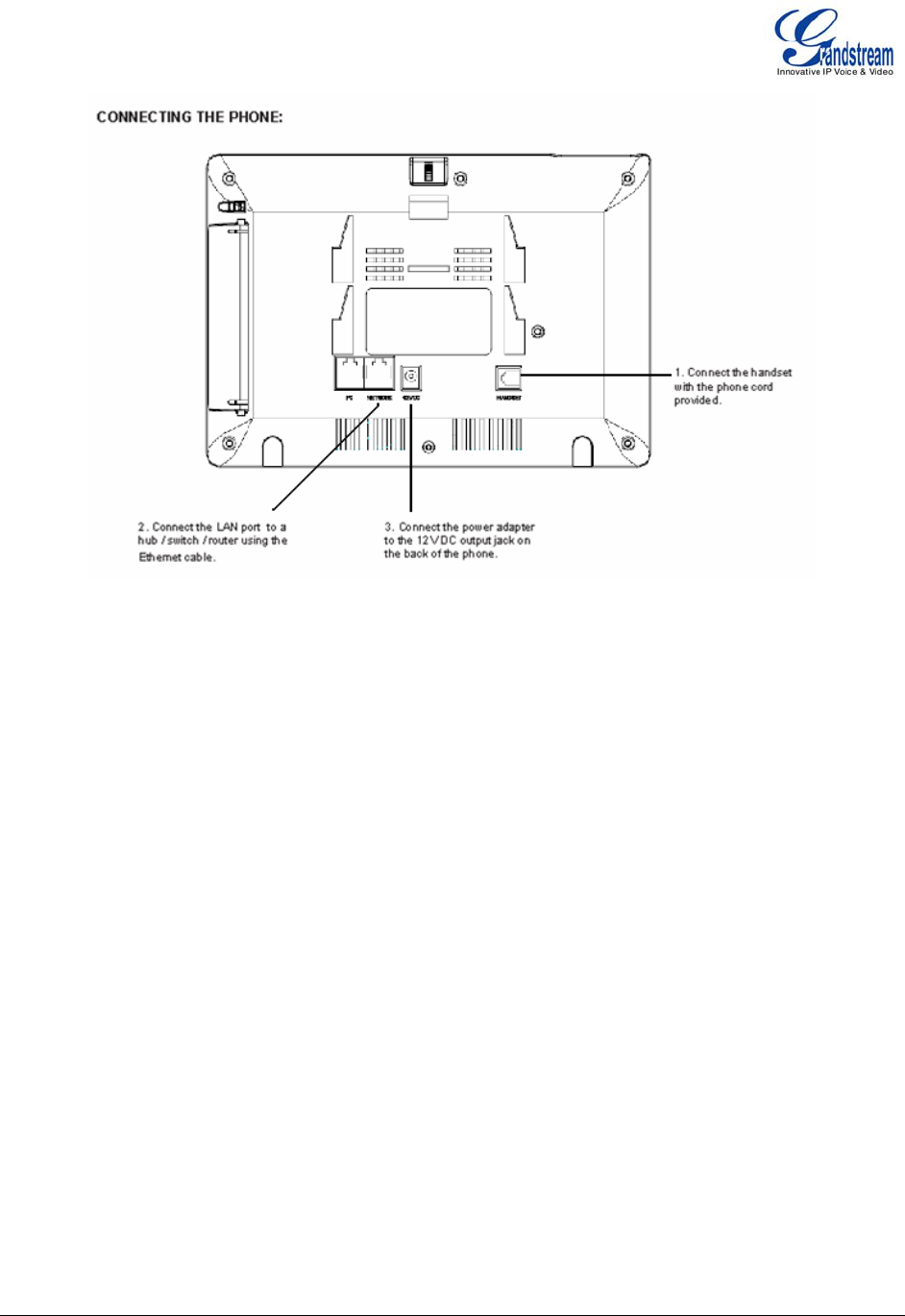
Figure 5: Connecting the GXV3175
MAKING THE FIRST CALL WITH IPVIDEOTALK SERVICE
The GXV3175 offers users the ability to send and receive free lifetime video calling to other GXV3175 on
the IPVideoTalk network. Once the GXV3175 is connected, video calls are made using Grandstream’s
configuration peer-to-peer SIP technology and IPVideoTalk service. To place the first video calling,
complete these three (3) simple steps:
1) Connect the handset to the phone using the handset cable provided. Connect the network cable
and the power cable to the GXV3175 using the methods described above. After the phone boots
up and obtains an IP address through DHCP, it will attempt to register to the IPVideoTalk network.
When the user boots the phone for the first time, Account 1 will be registered to the IPVideoTalk
server with a provisioned extension of 810xxxx.
2) If the registration is successful, the IPVideoTalk text on the LCD will turn green and an assigned
IPVideoTalk number (810xxxx) specific to this phone will be displayed. At this point, the phone is
ready for making and receiving video calls over the IPVideoTalk network.
3) Tap on the account (See Figure 5) in the touch screen then the dial pad will show up with dial
tone (See Figure 6). Dial the number of any other phone registered to the IPVideoTalk network. If
the user has purchased more GXV3175/GXV3140 IP Multimedia phones, these phones are able
to establish video calls between each other and the user will immediately experience the plug and
play nature of the GXV3175. If a user has only one GXV3175, the user can choose to experience
Grandstream Networks, Inc. GXV3175 USER MANUAL Page 9 of 68
FIRMWARE VERSION 1.0.0.32 Updated : 11/2010
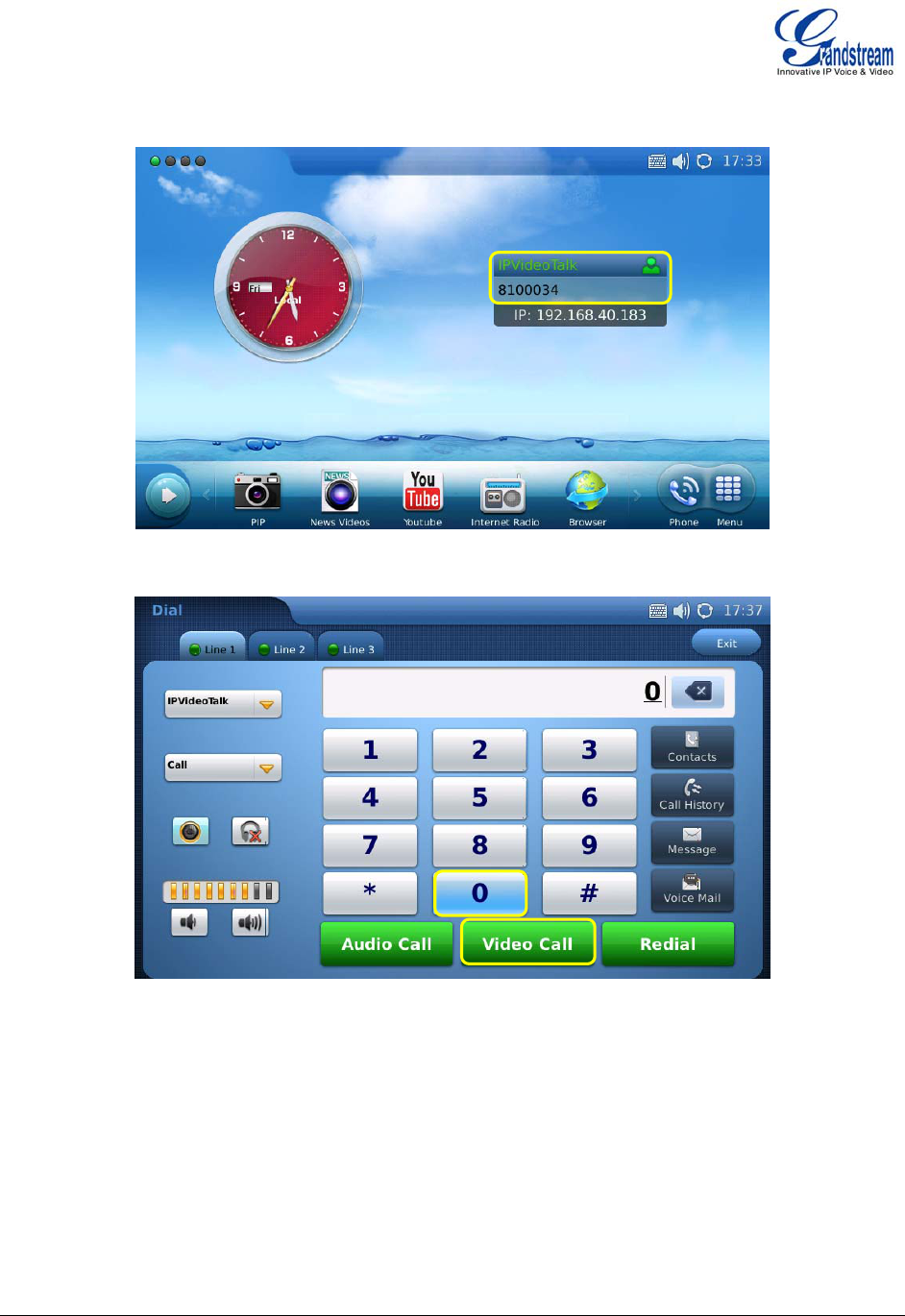
the multimedia features by dialing 0 to establish a video call with the preset extension on the
server.
Figure 6: Select IPVideoTalk account in the marked area to make first call
Figure 7: Press 0 and select Video Call
Grandstream Networks, Inc. GXV3175 USER MANUAL Page 10 of 68
FIRMWARE VERSION 1.0.0.32 Updated : 11/2010

Figure 8: Establishing Video Call in GXV3175
Grandstream Networks, Inc. GXV3175 USER MANUAL Page 11 of 68
FIRMWARE VERSION 1.0.0.32 Updated : 11/2010
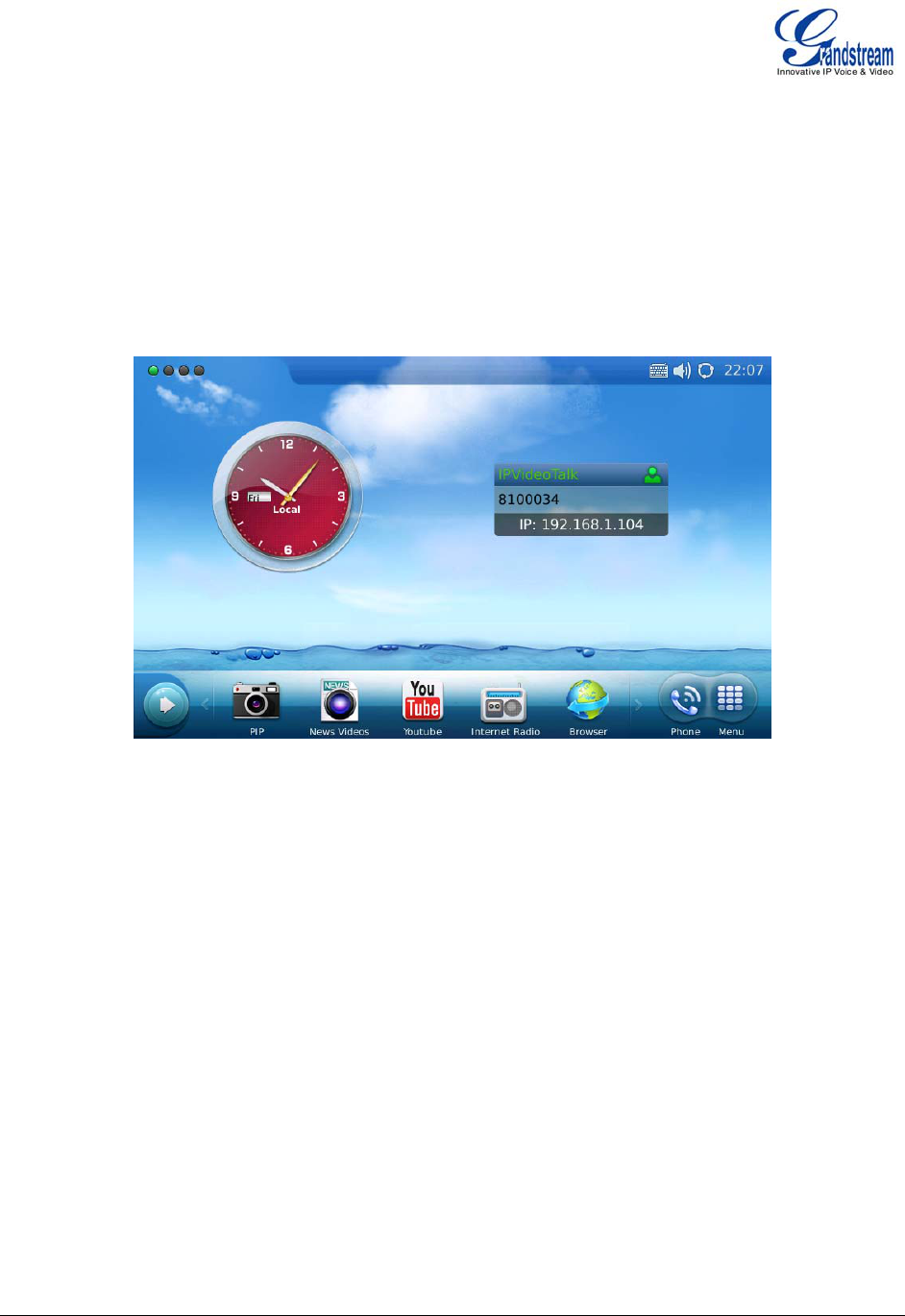
USING THE GXV3175 IP MULTIMEDIA PHONE
LCD
When the phone is idle, the LCD screen will look similar to Figure 9. (The account and IP address may be
different from case to case, depending on the network environment and the settings.)
Figure 9: GXV3175 LCD Idle Screen
Users could hold and drag on the center area of the main screen then slide from right to left to switch the
screen. In the left hand side of the status bar, there are four (4) green tabs indicating the current page of
the screen. Users could slide to left/right to view the different desktop widgets in the four screens. Figure
10 shows the screen that displays weather and currency information.
Grandstream Networks, Inc. GXV3175 USER MANUAL Page 12 of 68
FIRMWARE VERSION 1.0.0.32 Updated : 11/2010
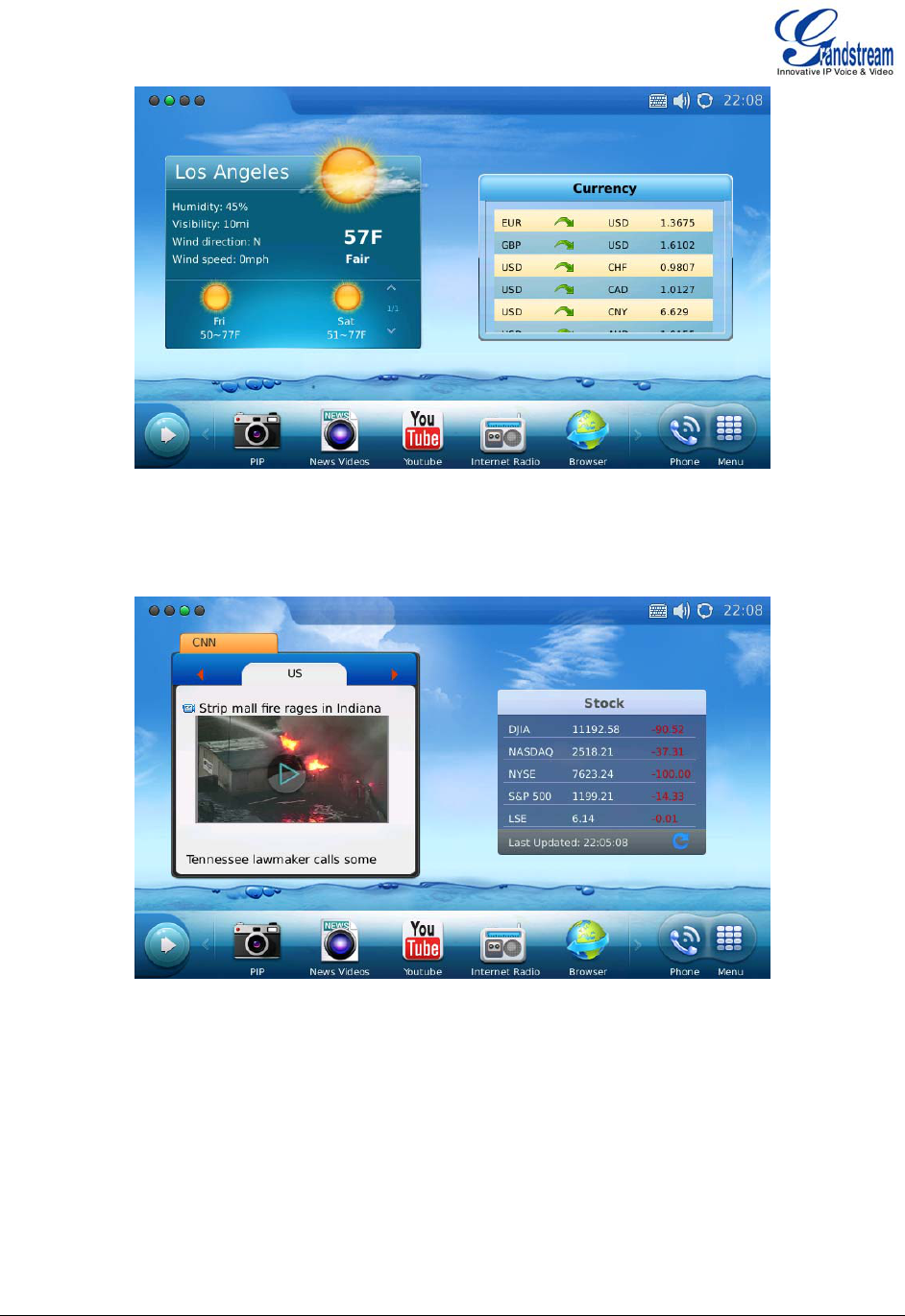
Figure 10: LCD IDLE screen displaying Weather and Currency Information
Move around all the way to left to switch to screen that displays News Videos and Stock information. See
Figure 11.
Figure 11: LCD IDLE screen displaying News Videos and Stock information
Switch again to a screen that shows Calendar and RSS News. See figure 12.
Grandstream Networks, Inc. GXV3175 USER MANUAL Page 13 of 68
FIRMWARE VERSION 1.0.0.32 Updated : 11/2010
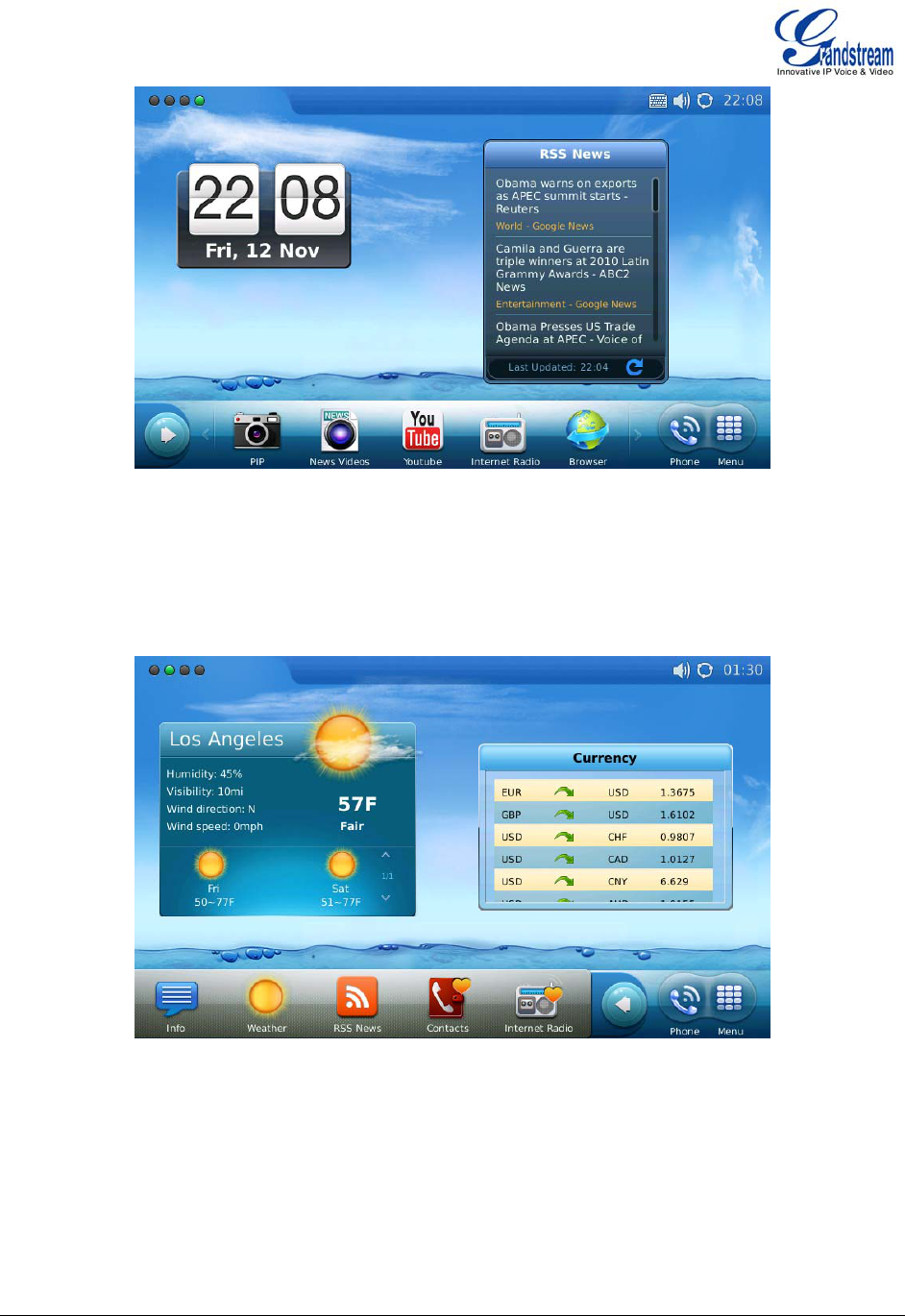
Figure 12: LCD IDLE screen displaying Calendar and RSS News
In every screen, users could select “Menu” icon to access the full menu, select “Phone” icon to make call,
select PIP/News Videos/Youtube/Internet Radio/Brower for these applications, or select the arrow button
on the left to open new widget which include Info, Weather, RSS News, Contacts and Internet Radio. See
Figure 13.
Figure 13: Open new widget in IDLE screen
Users may close/configure the widget by holding the widget area until close/setting options show up on
the right (Marked in Figure 14).
Grandstream Networks, Inc. GXV3175 USER MANUAL Page 14 of 68
FIRMWARE VERSION 1.0.0.32 Updated : 11/2010
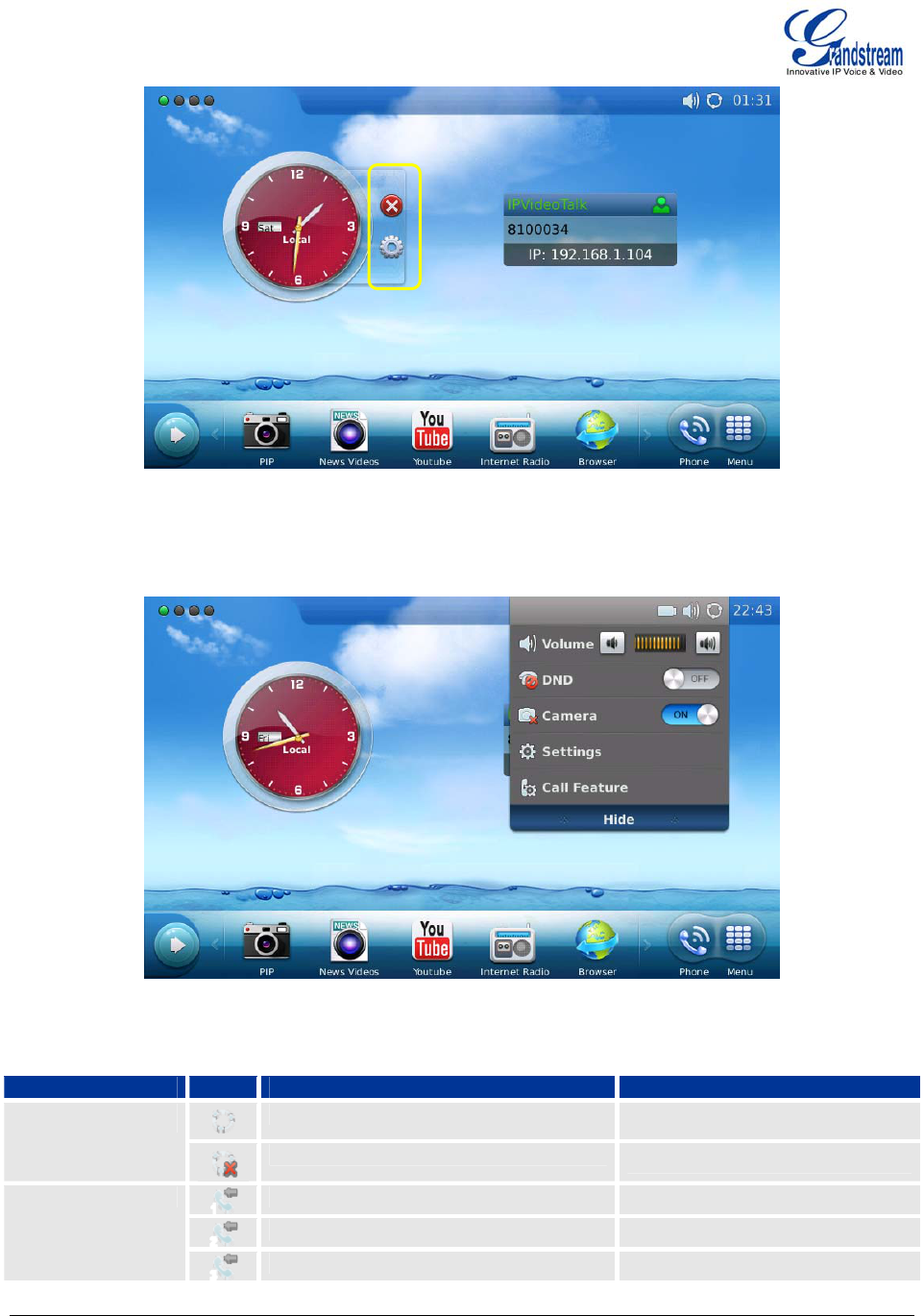
Figure 14: Close/Configure the widget in IDLE screen
By selecting the right hand side area of the status bar, users will be able to set the phone’s status in the
popped out dropdown list. See Figure 15.
Figure 15: LCD IDLE screen displaying status bar settings
Table 5: LCD Icon Definition
Type Icon Definition Note
Connected to the network Network
Failed to connect to the network
Account 1 Auto Answer
Account 2 Auto Answer
Call Related
Account 3 Auto Answer
Grandstream Networks, Inc. GXV3175 USER MANUAL Page 15 of 68
FIRMWARE VERSION 1.0.0.32 Updated : 11/2010
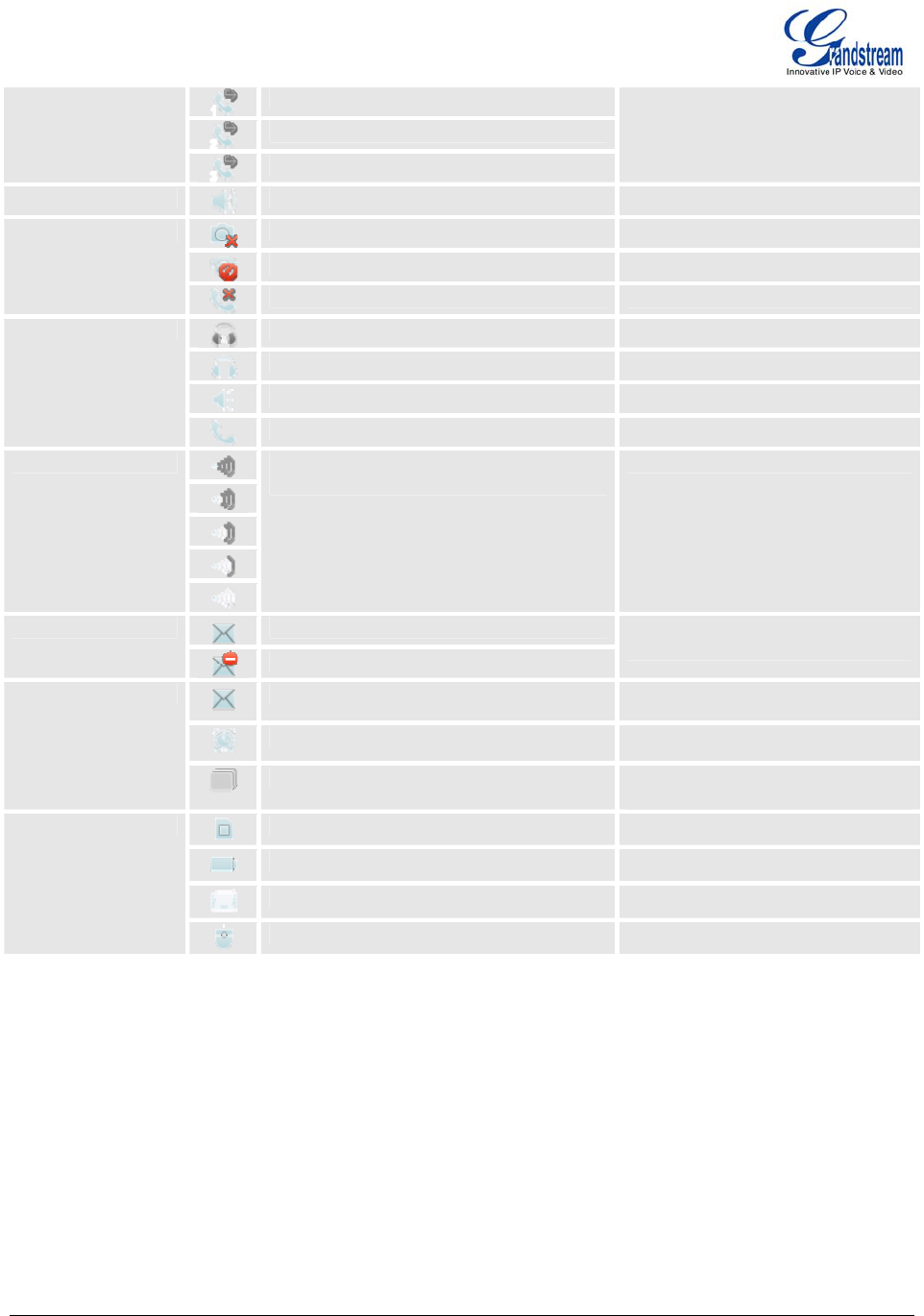
Account 1 Call Forward
Account 2 Call Forward
Account 3 Call Forward
If call forward is on: unconditional
forward, forward when busy or
forward on no answer.
Ring Volume Ring volume, ranges from 0-9
Camera disabled.
Do-Not-Disturb (DND)
Phone Status
Missed Call.
The headset is in use and is off hook.
The headset is plugged in.
The phone is on speaker.
Audio Output
The handset is off hook.
WiFi
WiFi signal strength, ranging from 0 to
4
Unread message Message
Message box is full
The icon is displayed at the right
hand side of the status bar
Unread text message.
Alarm clock
Applications
Background running program The icon is displayed at the
center of the status bar
SD card
USB flash drive.
USB keyboard
External devices
USB mouse
Grandstream Networks, Inc. GXV3175 USER MANUAL Page 16 of 68
FIRMWARE VERSION 1.0.0.32 Updated : 11/2010
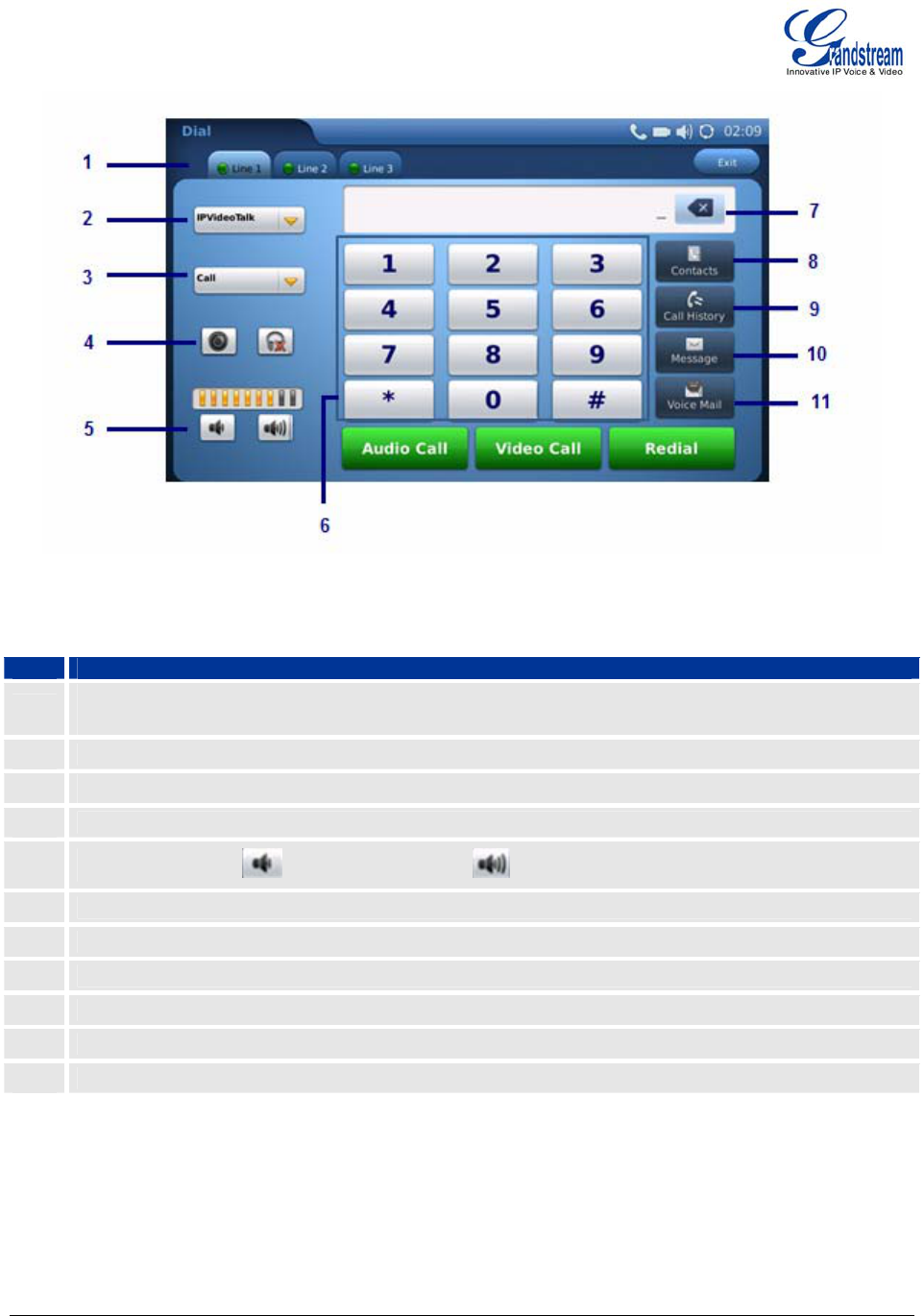
Figure 16: GXV3175 Dial Pad
Table 6: GXV3175 Dial Pad Definition
Item Definition
1 Line/Account selection. Three independent SIP accounts may be configured, and the Line options
can be used to choose the line/account for audio/video call.
2 Account option. Dropdown list will show all the registered account for selection.
3 Call option. Dropdown list will show three types of call: Call, Paging and IP Call.
4 Audio output. Three types of audio output are available: speaker, handset and headset.
5 Call volume. Press to turn down or press to turn up the volume.
6 Standard keypad.
7 Delete input number. Press to delete the input number when dialing out.
8 Contacts. Press to open contact list.
9 Call History. Press to open call history.
10 Message. Press to open message box.
11 Voice Mail. Press to access voice mail box.
MULTIPLE SIP ACCOUNTS AND LINES
The GXV3175 supports up to 3 independent SIP accounts. Each account may have separate SIP servers,
usernames and NAT configurations. The registered account will display in the idle screen by default.
When the phone is off-hook, users could press Line1/Line 2/Line 3 or the account option to switch
Grandstream Networks, Inc. GXV3175 USER MANUAL Page 17 of 68
FIRMWARE VERSION 1.0.0.32 Updated : 11/2010

between different SIP accounts.
Incoming calls through the three accounts will try to use the corresponding line. If this line is busy, the
green icon for the corresponding line will become red. When a call comes in and the line is busy, the next
idle line will be used.
HANDSET, SPEAKER AND HEADSET MODE
The GXV3175 allows users to switch from handset to speaker or headset by pressing corresponding
icons shown in Dial Pad (Item 5). If headset is plugged in, the headset icon will be activated to select.
MAKING A CALL
There are several ways to make a call.
1. By selecting account displayed in idle screen
Users could press the account area displayed in idle screen to make a call via the selected
account.
• In idle screen, select the registered account by touching the marked area in Figure.
• The dial pad will show up with the selected account.
• Dial the number and press “Audio Call”/”Video Call” to dial out. Or press “Redial” for the
last dialed number.
Figure 17: Making a call by select account displayed in IDLE screen
2. By “Phone” in idle screen
Grandstream Networks, Inc. GXV3175 USER MANUAL Page 18 of 68
FIRMWARE VERSION 1.0.0.32 Updated : 11/2010
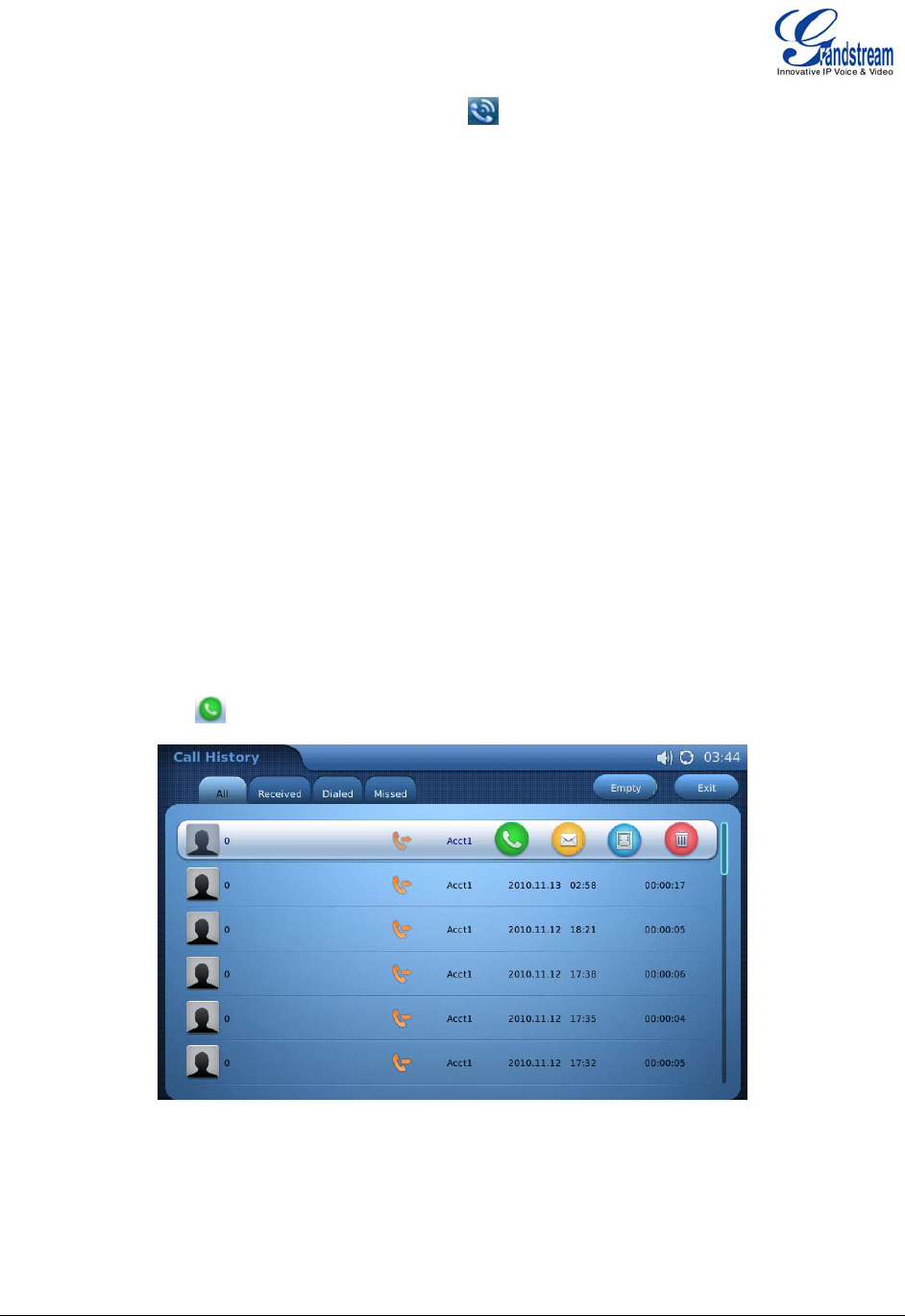
• In idle screen, select the “Phone” icon at the right bottom corner.
• The dial pad will show up with dial tone.
• Dial the number and press “Audio Call”/”Video Call” to dial out. Or press “Redial” for the
last dialed number.
3. By taking handset off hook
Users will be able to make a call when the phone is idle or running other applications by taking
the handset off hook.
• Take the handset off hook then the dial pad will show up with dial tone.
• Select line/account.
• Press “Redial” or dial the number and press “Audio Call”/”Video Call” to dial out.
4. By Call History
• Access the Phone Menu by pressing “MENU” icon in idle screen, and then select “Call
history”.
• The LCD monitor will display “All” calls, “Received” calls, “Dialed” calls and “Missed calls”.
Select the call history that you wish to view.
• Press to dial the selected number. (See figure 18)
Figure 18: Dial by Call History
5. By Contacts
• Access the Phone Menu by pressing “MENU” icon in idle screen, and then select
“Contacts”. Or choose “Contacts” icon in dial pad to access contact list.
Grandstream Networks, Inc. GXV3175 USER MANUAL Page 19 of 68
FIRMWARE VERSION 1.0.0.32 Updated : 11/2010
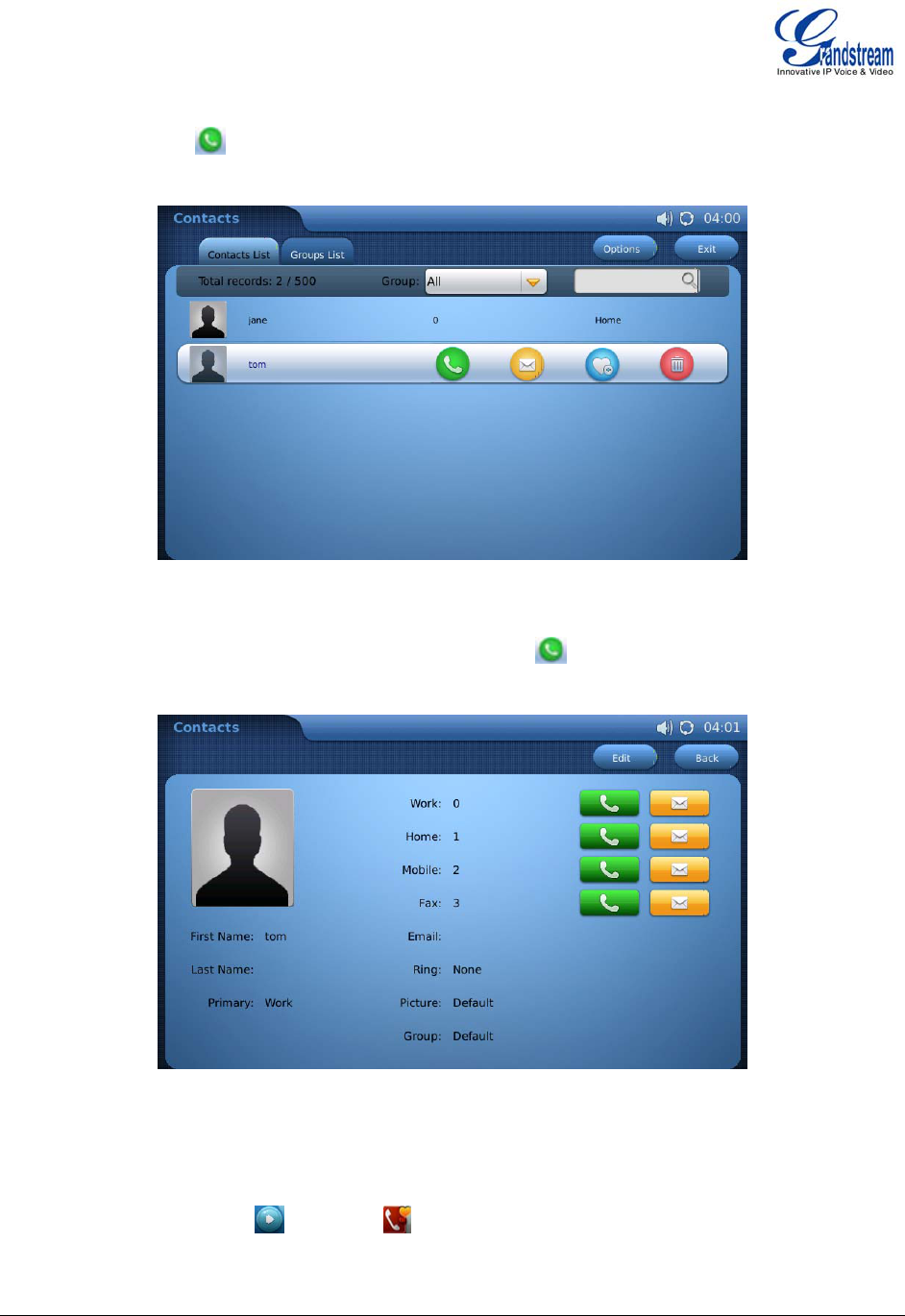
• The LCD monitor will display the contact list. Scroll to the contact to be dialed.
• Press to call the select contact. The primary number of the contact will be dialed out.
See Figure 19.
Figure 19: Dial by Contact List
• If selecting the contact for full contact information, there will be four numbers available to
dial out: Home, Work, Mobile and Fax. Press to dial the corresponding number. See
Figure 20.
Figure 20: Dial by Contact List – more contact information
6. By Contact Favorite in idle screen
In idle screen, press and select to open the contact favorite widget. Users could add the
Grandstream Networks, Inc. GXV3175 USER MANUAL Page 20 of 68
FIRMWARE VERSION 1.0.0.32 Updated : 11/2010

contact to the favorite list. Select the contact and press to dial out. (See figure 21)
Figure 21: Dial by Contact Favorite in idle screen
7. By Messages
Users could access the Phone Menu by pressing “MENU” icon in idle screen, and then select
“Message”. Similar to dialing by Call History, press to dial the selected contact in message
history.
DURING CALLS
ANSWERING CALLS
1. Incoming Video Call: When the phone rings, select “Accept Audio”, “Accept Video” or “Reject”.
(See Figure 22) Users could toggle among handset/speaker/headset to answer the call and
adjust the call volume as well.
Grandstream Networks, Inc. GXV3175 USER MANUAL Page 21 of 68
FIRMWARE VERSION 1.0.0.32 Updated : 11/2010
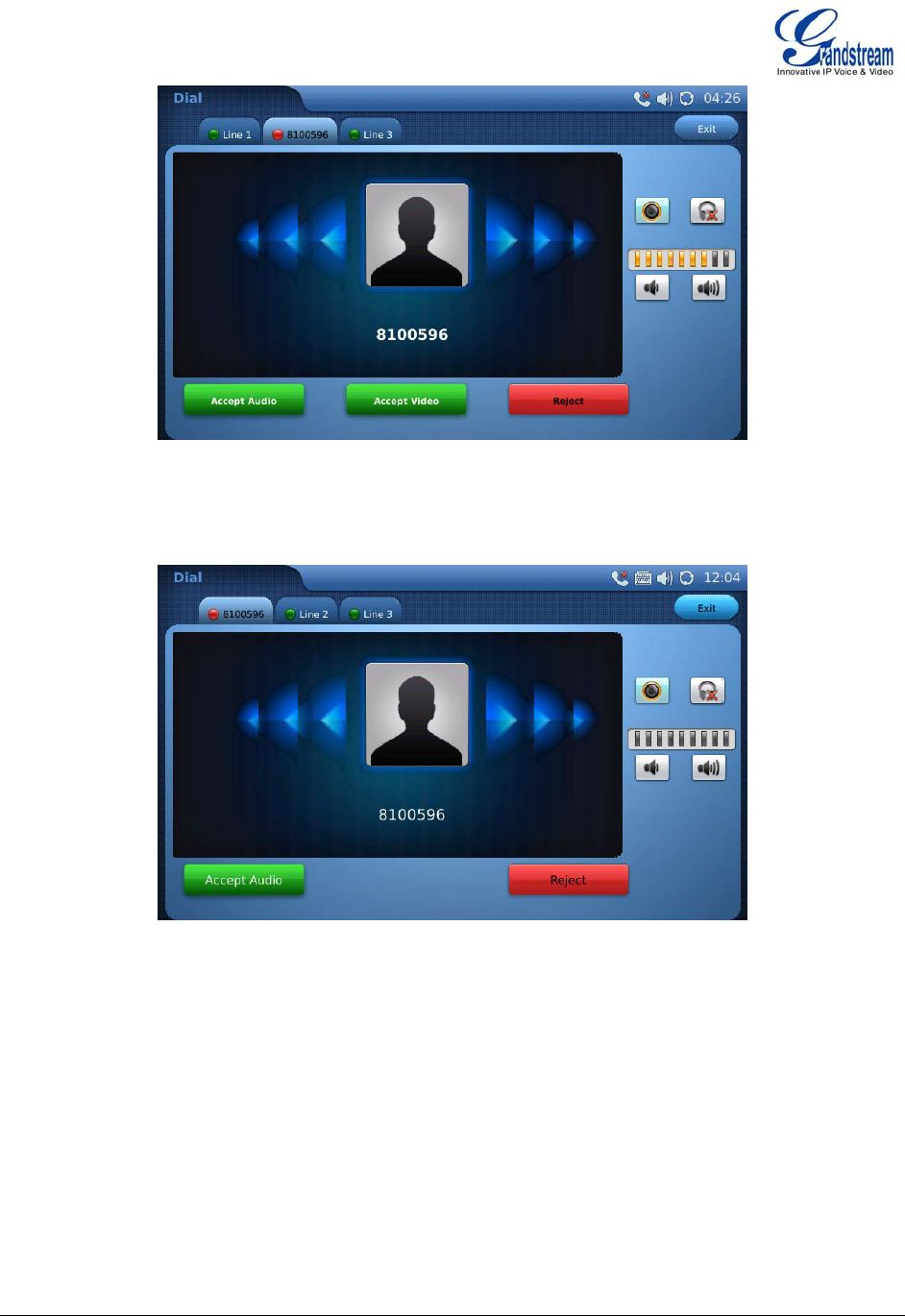
Figure 22: Answer incoming video call
2. Incoming Audio Call: When an audio call is coming in, select “Accept Audio” or “Reject” in the
screen shown as Figure 23.
Figure 23: Answer incoming video call
3. Missed Call: if the call is unanswered, a missed call message will show up in idle screen. (See
Figure 24). Users could press View to access the missed call detail.
Grandstream Networks, Inc. GXV3175 USER MANUAL Page 22 of 68
FIRMWARE VERSION 1.0.0.32 Updated : 11/2010

Figure 24: Answer incoming video call
CALL FUNCTION OPTIONS
Figure 25 shows the screen after the users answer the call. Press “Options” button with the UP arrow to
access all the call functions.
Figure 25: During a video call
Grandstream Networks, Inc. GXV3175 USER MANUAL Page 23 of 68
FIRMWARE VERSION 1.0.0.32 Updated : 11/2010

Figure 26: Call Function Options
Table 7: GXV3175 Call Function Description
OPTION MENU FUNCTION DESCRIPTION
Camera On Press to switch between Camera On and Camera Off
PIP Press to switch videos between the caller and callee
Hold Press to hold the call
Mute Press to mute/unmute the call
Transfer Press to make transfer to the third party
Conference Press to make 3-way conference call
Snapshot Press to take a snapshot of the current video. The
snapshot will be automatically saved to folder
“screenshoot” in Tools->File Manager
Video off Press to switch between Video off and Video on. In the
screen, the default picture will show instead of the video
when video is turned off
Turn up and turn down the video brightness
Video zoom in and turn out
DTMF Dial Pad Press the number and # or * for DTMF
CALL HOLD
1. Call Hold:During a call, press “Hold” button to place the call on hold. The line icon will become
yellow after call hold. The following will be displayed on the screen. (See Figure 27)
Grandstream Networks, Inc. GXV3175 USER MANUAL Page 24 of 68
FIRMWARE VERSION 1.0.0.32 Updated : 11/2010
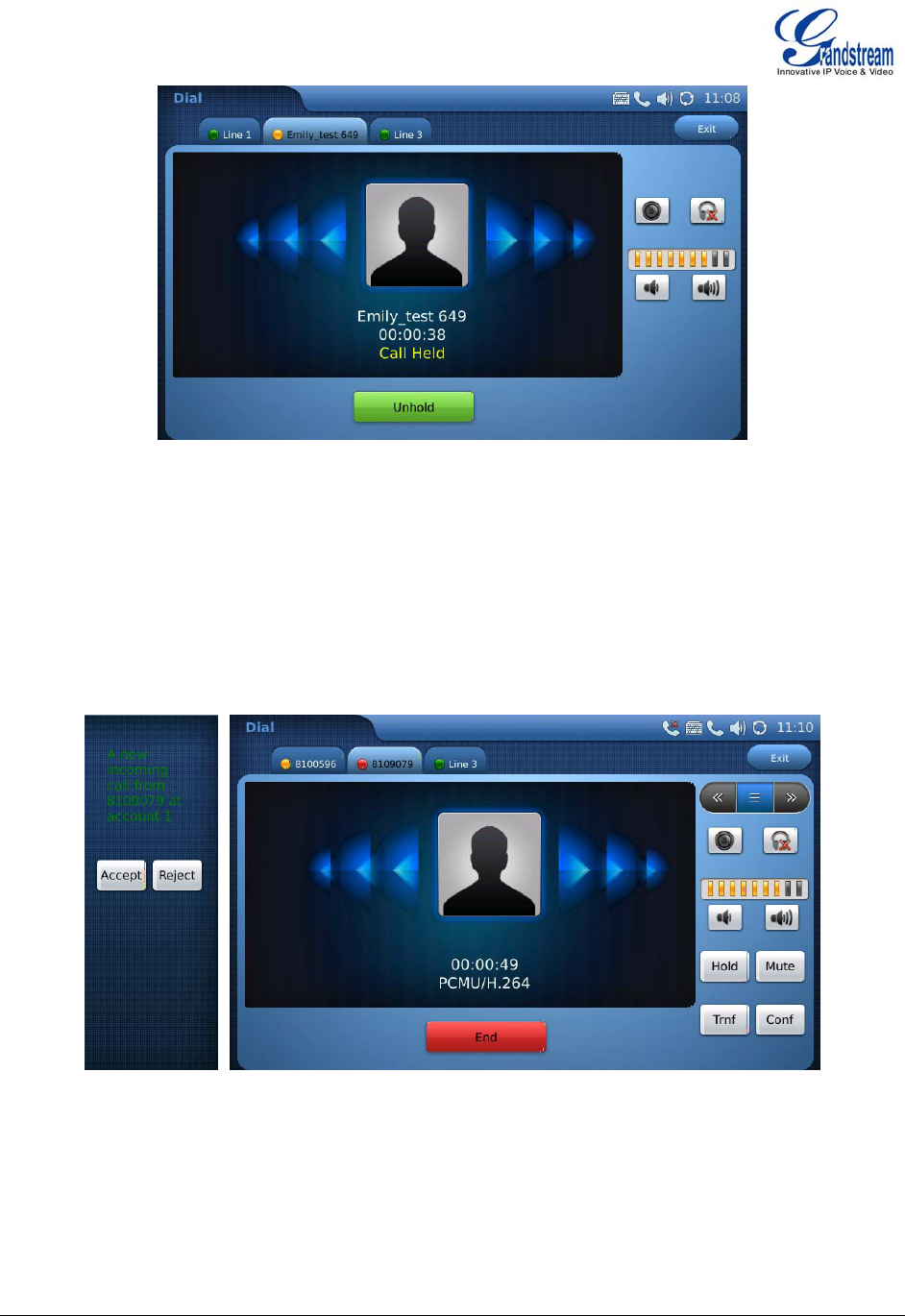
Figure 27: Call Hold
2. Call Resume: In Figure 27, press “Unhold” button to resume to the call.
3. Multiple Calls: After call hold, users could select another line to make calls. If there is another
call coming in, the user will be able to select “Accept” or “Reject” in the right hand side of the
screen. Accept new incoming call will put the previous call on hold. To toggling between several
calls, users may need to turn off the video first by tapping on “Video off” in “Option” (See Figure
24) if it is a video call. Then the following figure will show up for users to select between multiple
lines. See Figure 28.
Figure 28: Multiple Calls
CALL TRANSFER
1. Blind Transfer: During a call, press the “Transfer” button to place the other party on hold. The
phone will display the following message: “Dial Number (Blind) OR Select Line (Attended)”. (See
Figure 29). Dial the extension number and press “Send”. This will transfer the call to the other
Grandstream Networks, Inc. GXV3175 USER MANUAL Page 25 of 68
FIRMWARE VERSION 1.0.0.32 Updated : 11/2010
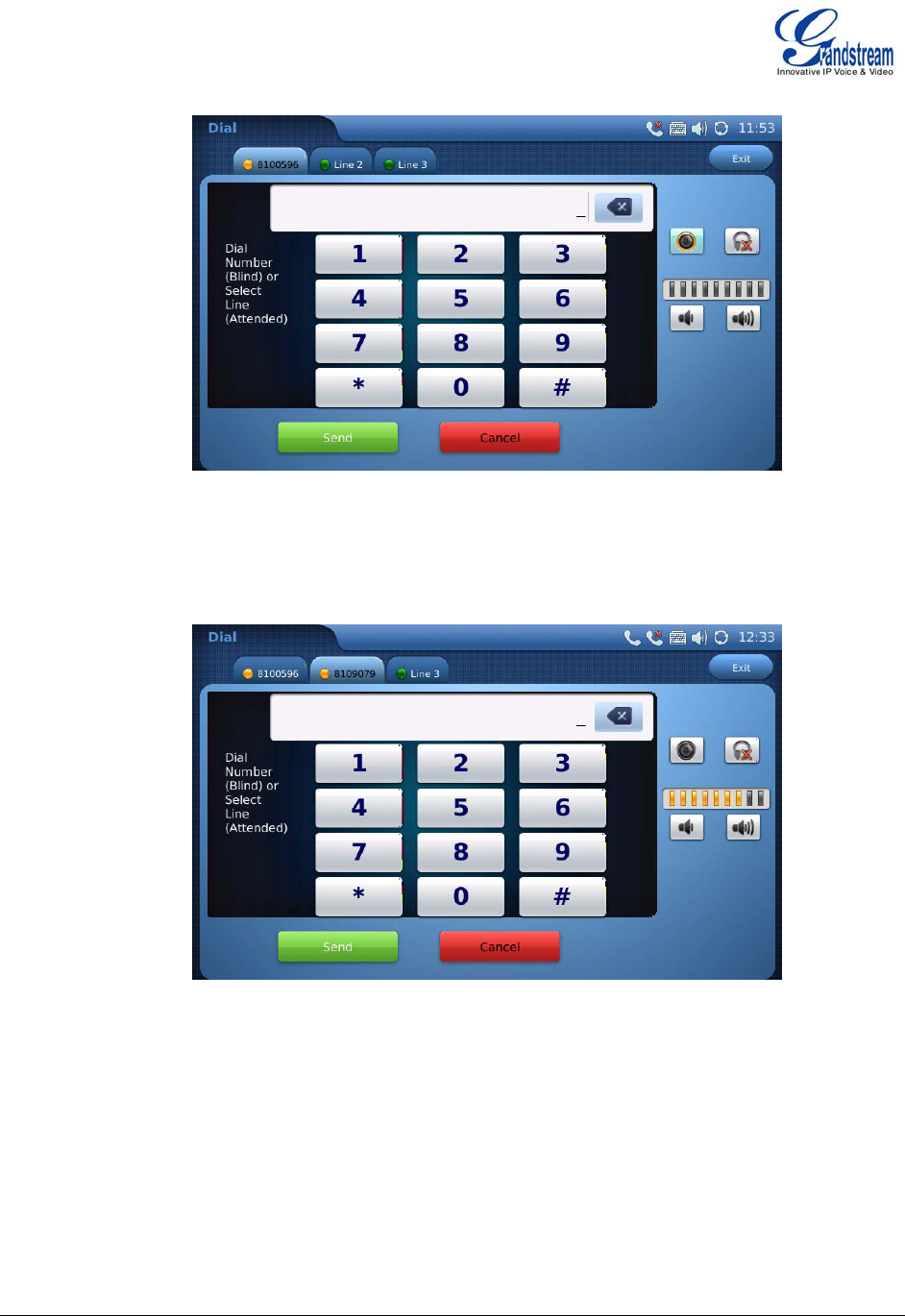
party immediately.
Figure 29: Blind Transfer
2. Attended Transfer: During a call, select another line to establish call with the third party using
the same account. This will put the previous line (Line 1) on hold. Now, press the “Transfer”
button and the message: “Dial Number (Blind) OR Select Line (Attended)” will show up in the
screen. Then select Line 1 to finish attended transfer. (See Figure 30)
Figure 30: Attended Transfer
NOTE:
• To transfer calls across SIP domains, SIP service providers must support transfer across SIP
domains.
• If users enter a wrong number and wish to cancel the transfer, just press the “Cancel” in the
screen shown in Figure 27. Then the call with the first party will resume automatically.
• If the user is on a video call with the first party, the users may need to turn off the video by
pressing “Video off” or pressing “Hold” to activate the screen to select another line.
Grandstream Networks, Inc. GXV3175 USER MANUAL Page 26 of 68
FIRMWARE VERSION 1.0.0.32 Updated : 11/2010

3-WAY CONFERENCE
The GXV-3175 supports 3-way video conferencing. See Figure 31.
Figure 31: 3-Way Conference
1. Initiate a Conference Call: During a call, select another line by pressing “Line” button to call the
second party using the same account. This will place the first call on hold. Once the user has
established the second call, press the “Conference” button then select the line on hold by
pressing the corresponding “Line” button. This would bring the three parties together in a 3 way
conference.
2. Cancel the Conference: If after pressing the “Conference” button, a user decides not to
conference anyone, press “Cancel” to cancel the conference.
3. End the Conference: There are two ways to end a conference: The first way is to press “END” in
the conference call. The second way to end a conference is to simply hang up and terminate the
call.
NOTE:
• During the conference, users can see three-way videos if it is video call.
• To activate the call options during the conference, users could simply tap on the screen then the
options will show up. Press PIP button to change the layout of the video display for the three
parties.
• During the three way conference, if the initiator of the conference hangs up, the conference will
end. If users wish to allow the remaining two parties to stay in conversation after the initiator
hangs up, the conference initiator should set “Transfer on Conference Hangup” to “Yes” in the
web configuration interface. This would allow the transfer of call to the remaining party after the
initiator exits the conference.
• If the user is on a video call with the first party, the users may need to turn off the video by
pressing “Video off” or pressing “Hold” to activate the screen to select another line.
Grandstream Networks, Inc. GXV3175 USER MANUAL Page 27 of 68
FIRMWARE VERSION 1.0.0.32 Updated : 11/2010

VOICEMAIL(MESSAGE WAITING INDICATION)
If the blue Message Waiting Indication (MWI) LED icon is flickering in the HOME button, a new voice mail
has been received and is waiting to be retrieved. To retrieve the voice mail, activate dial pad first. Then
dial the voicemail box number or press Voice Mail button (the button needs to be configured first).
The Interactive Voice Response (IVR) prompts the user through the message retrieval process. The users
may need to navigate to call function option and use the DTMF keypad for voicemail options.
NOTE: Each of the 3 accounts has its own voicemail. The Voicemail access number may be set up in the
“Voicemail ID” configuration under “Accounts” in the web configuration interface.
MUTE
1. During a call, the LCD screen will display “Mute”. Select the button to mute the call.
2. After the “Mute” button is pressed, the LCD screen will display “Unmute”. When this button is
pressed, the mute feature is cancelled.
KEYPAD INPUT
The build-in soft keypad in GXV3175 supports English and Chinese for text input. See Figure 32.
Figure 32: GXV3175 Soft Keypad
Table 7: GXV3175 Keypad Definition
Item Function
1 Caps lock.
Grandstream Networks, Inc. GXV3175 USER MANUAL Page 28 of 68
FIRMWARE VERSION 1.0.0.32 Updated : 11/2010

Grandstream Networks, Inc. GXV3175 USER MANUAL Page 29 of 68
FIRMWARE VERSION 1.0.0.32 Updated : 11/2010
2 Hide Keypad
3 Switch between English/Chinese input.
4 Switch between Letter/Number/Symbol
5 Delete
NOTE: External Keyboard could also be used by plugging via USB port on the phone.

Grandstream Networks, Inc. GXV3175 USER MANUAL Page 30 of 68
FIRMWARE VERSION 1.0.0.32 Updated : 11/2010
CALL FEATURES
These are the feature codes for call features. To use the code, select the line you wish to use by pressing
the LINE button and enter the feature code.
Table 6: Call Features
Code Feature
*01 Select the preferred video/audio codec used for the call. Dial *01 + codec feature code +
Phone/Ext. Number (See Table 8 for codec feature code)
*02 Force the video/audio codec used for the call. Dial *02 + codec feature code + Phone/Ext.
Number (See Table 8 for codec feature code)
*30 Block Caller ID (for all subsequent calls)
*31 Send Caller ID (for all subsequent calls)
*50 Disable Call waiting (for all subsequent calls)
*51 Enable Call Waiting (for all subsequent calls)
*67 Block Caller ID (per call): Dial *67 + Phone/Ext. Number (no dial-tone in between).
*82 Send Caller ID (per call): Dial *82 + Phone/Ext. Number (no dial-tone in between).
*83 Send audio only: Dial *83 + Phone/Ext. Number (no dial-tone in between)
*84 Send audio and video: Dial *84 + Phone/Ext. Number (no dial-tone in between)
*70 Disable Call Waiting (per call): Dial *70 + Phone/Ext. Number (no dial-tone in between).
*71 Enable Call Waiting (per call): Dial *71 + Phone/Ext. Number (no dial-tone in between).
*72 Unconditional Call Forward: Dial *72 + Phone/Ext. Number followed by the # key. Wait for a
dial-tone and then hang up (dial-tone means input is successful).
*73 Cancel Unconditional Call Forward: Dial *73 and wait for a dial-tone before hanging up.
*90 Busy Call Forward: Dial *90 + Phone/Ext. Number followed by the # key. Wait for a dial- tone
and then hang up.
*91 Cancel Busy Call Forward: dial *91 and wait for a dial-tone before hanging up.
*92 Delayed Call Forward: Dial *92 + Phone/Ext. Number followed by the # key. Wait for a dial-
tone and then hang up.
*93 Cancel Delayed Call Forward: Dial *93 and wait for a dial-tone before hanging up.
Table 7: GXV3140 Audio/Video Codec Feature Code
Codec Feature Code
PCMU 7110
PCMA 7111
G723 723
G726-32 72632
G729 729
G722 722
GSM 7200
L16-256 7202
H.264 264
H.263 263

Grandstream Networks, Inc. GXV3175 USER MANUAL Page 31 of 68
FIRMWARE VERSION 1.0.0.32 Updated : 11/2010
H.263+ 2631998
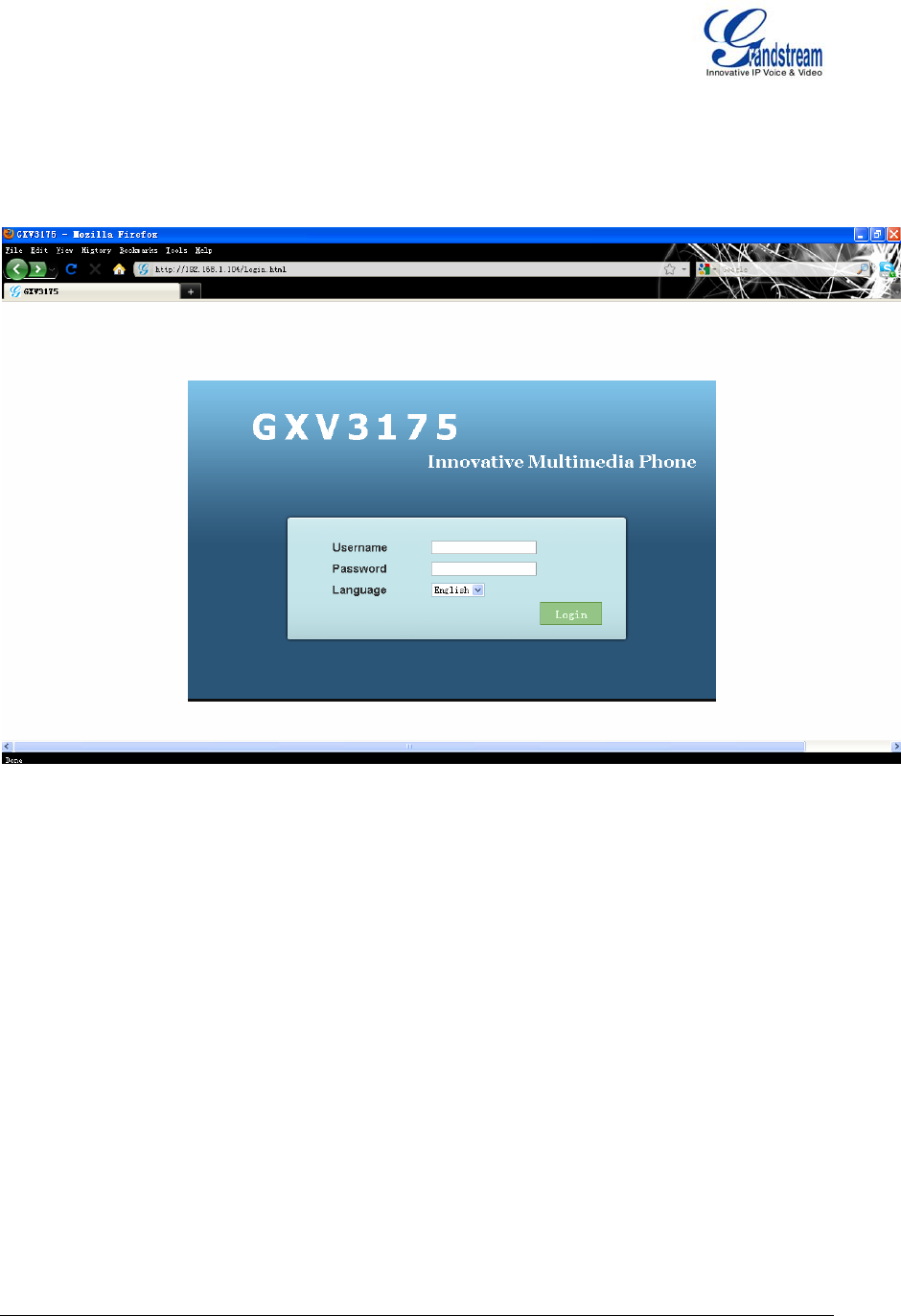
GXV3175 WEB CONFIGURATION INTERFACE
The GXV-3175’s embedded Web server responds to HTTP/HTTPS GET/POST requests.
Embedded HTML pages allows users to configure the IP Multimedia Phone through a Web
browser such as Microsoft’s IE or Mozilla Firefox (Java Script must be enabled).
Figure 33: Web Browser Interface for GXV3175
ACCESSING THE WEB CONFIGURATION PAGES
The GXV3175 Web Configuration Interface URL is http://Phone-IP-Address, where the Phone-IP
Address is the IP address displayed on the phone’s LCD screen.
To access the phone’s Web Configuration Menu:
• Connect the computer to the same network as the phone.
• Make sure the phone is turned on and shows its IP-address on the LCD display.
• Open a Web-browser on your computer.
• Enter the phone’s IP-address in the address bar of the browser.
• Enter the administrator’s login and password to access the Web Configuration Menu.
1. The computer has to be connected to the same sub-network as the phone. This is easily
done by connecting the computer to the same hub or switch as the phone it is connected
to. In absence of a hub/switch (or free ports on the hub/switch), please connect the
computer directly to the phone using the PC-port on the phone.
2. If the phone is properly connected to a working Internet connection, the phone will display
its IP address. This address has the format: xxx.xxx.xxx.xxx, where xxx stands for a
number from 0-255. Users will need this number to access the Web Configuration Menu.
For example, if the phone shows 192.168.0.60, please enter “http://192.168.0.60” in the
Grandstream Networks, Inc. GXV3175 USER MANUAL Page 32 of 68
FIRMWARE VERSION 1.0.0.32 Updated : 11/2010

Grandstream Networks, Inc. GXV3175 USER MANUAL Page 33 of 68
FIRMWARE VERSION 1.0.0.32 Updated : 11/2010
address bar of the browser.
3. The default login name for the administrator is “admin”. The default administrator
password is set to “admin”. The default login name for end-users is “user” while the
default user password is set to “123”.
NOTE: When changing any settings, always SUBMIT them by pressing the SAVE button on the
bottom of the page. For those settings that are shown in the web user interface (UI) with a star “*”
next to it, users must reboot the phone for the changes to take effect.
DEFINITIONS
This section describes the options in the Web configuration user interface. As mentioned, you can
log in as an administrator or an end-user.
• Status: Displays the Account status, Network status, and System info of the phone.
• Account (1~3): To configure each of the SIP accounts.
• Advanced Settings: To configure General settings, Call Features, Video Settings, and
Ring Tones.
• Maintenance: To configure Network Settings, WiFi Settings, Time Settings, Web/Telnet
Access, Upgrade, Syslog, Debug, Language, Network Manager, OpenVPN Settings and
Device Manager.
STATUS PAGE DEFINTIONS
Status/Account Status
Account Shows the status of the 3 accounts.
Number Shows the extension number of the SIP account.
SIP Server Shows the URL/IP address and port of the SIP server.
Status Shows the status of the account.
Status/Network Status
MAC Address The device ID, in HEX format. This is a very important ID for ISP
troubleshooting.
Address Type This field shows the type of address configured: DHCP, Static IP or
PPPoE.
IP Address This field shows the IP address of the GXV-3175.
Subnet Mask This field shows the subnet mask of the GXV-3175.
Default Gateway This field shows the Gateway of the GXV-3175.
DNS Server This field shows the DNS Server of the GXV-3175.
NAT Type This field shows the type of NAT configured.
Status/System Info
Product Model Defines the product model: GXV3175.
Hardware Revision Hardware version number: Main Board, Interface Board.

Grandstream Networks, Inc. GXV3175 USER MANUAL Page 34 of 68
FIRMWARE VERSION 1.0.0.32 Updated : 11/2010
Part Number This field contains the product part number.
Serial Number This field contains the product serial number.
Software Version • Program: This is the main firmware release number, which is
always used for identifying the software (or firmware) system of the
phone.
• Boot: Booting code version number.
• Core: Core code version number.
• DSP: DSP code version number.
• Base: Base code version number.
• GUI-A, GUI-B: GUI interface version number.
• Recover Image: Recover image version number.
• Supplement: Supplement version number.
System Up Time This field shows system up time since the last reboot.
ADVANCED SETTINGS PAGE DEFINITIONS
Advanced Settings/General Settings
Local RTP Port This parameter defines the local RTP-RTCP port pair used to listen and
transmit. It is the base RTP port for channel 0. When configured, for audio,
channel 0 will use this port _value for RTP and the port_value+1 for its
RTCP; channel 1 will use port_value+4 for RTP and port_value+5 for its
RTCP. For video, channel 0 will use port_value+2 for RTP and
port_value+3 for its RTCP; channel 1 will use port_value+6 for RTP and
port_value+7 for RTCP. The default value is 5004.
Use Random Port When set to YES, this parameter will force random generation of both the
local SIP and RTP ports. This is usually necessary when multiple GXV-
3175s are behind the same full cone NAT. The Default setting is YES. (This
parameter must be set to NO before Direct IP Calling will work)
Keep-alive Intervals (s) This parameter specifies how often the GXV-3175 sends a blank UDP
packet to the SIP server in order to keep the “ping hole” on the NAT router
to open. The default setting is 20 seconds.
STUN Server The IP address or Domain name of the STUN server. STUN resolution
results are displayed in the STATUS page of the Web UI. Only non-
symmetric NAT routers work with STUN.
Default STUN server: stun.ipvideotalk.com
Use NAT IP The NAT IP address used in SIP/SDP messages. This field is blank at the
default settings. This should ONLY be used if your ITSP requires it.
SSL Certificate This defines the SSL certificate needed to access certain websites.
SSL Private Key This defines the SSL Private key.
SSL Private key Password This defines the SSL private key password.
Advanced Settings/Call Features
Disable Call-Waiting The default setting is No. If set to Yes, the call waiting feature will be
disabled.
Disable Call-Waiting The default setting is No. If set to Yes, the call waiting tone will be

Grandstream Networks, Inc. GXV3175 USER MANUAL Page 35 of 68
FIRMWARE VERSION 1.0.0.32 Updated : 11/2010
Tone disabled.
Disable Direct IP Call The default setting is No. If set to Yes, Direct IP calling will be
disabled.
Offhook Auto Dial Configure a User ID/extension to dial automatically when the phone
is taken offhook. By default, the phone will use the first account to
dial out.
Advanced Settings/Video Settings
Enable Motion Detection The phone will exit idle/screensaver mode if motion is detected. The
default setting is Yes.
Video Frame rate The Default value is 15 frames/second. The video frame rate is
adjustable based on network conditions.
Increasing the frame rate will increase the amount of transferred data
significantly therefore consuming more bandwidth. Lack of bandwidth
will impair the video due to packet loss.
Video Packet Size The Default value is 1400, range from 100 to 1400.
It is recommended to use 600~800 if you have an Outbound Proxy
or Media Gateway.
Video Rate Control Frame, TMN8 or GOP. The Default setting is Frame.
TMN8 is good for bandwidths larger than 384kbps
Video Frame Skipping Skips bad video frames as they are received
The Default setting is No.
I-Frame Reference Only When enabled, all P frames will only have reference to previous I
frames. This method may improve video quality when the network
has heavy packet loss. It will have modest increase in bandwidth
usage. The Default setting is No.
Packetization-Mode The packetization mode (0 or 1) for the H.264 video packets. The
default setting is 0.
Redundant P-frame This setting allows the phone to send redundant P-frames of I
frames. When an I frame is delayed or has packet loss, the
redundant P-frames will be used instead. It may make video phone
call less prone to errors and thus make the video stream more robust
towards error propagation, but may increase bandwidth usage. The
default setting is set to No.
Adaptive MB Intra
Refresh
This parameter specifies whether Adaptive MB Intra Refresh is used
or not. It may protect most important MBs (macro blocks) subjected
to packet loss and to avoid error propagation. The intra-refresh rate
is adapted according to the video packet loss rate. It may increase
bandwidth usage. The default setting is set to No.
Video Packet Loss Rate Specifies the video packet loss rate for the Adaptive MB Intra
Refresh. Users can choose from: Less than 5%, Less than 10%,
Less than 15%, Less than 20%, Less than 25%. The default setting
is set to Less than 10%.
Advanced Settings/Ring Tone
Call Progress Tones:
Dial Tone
Ring Back Tone
Using these settings, users can configure ring or tone frequencies
based on parameters from the local telecom provider. By default,
they are set to the North American standard.
Frequencies should be configured with known values to avoid

Grandstream Networks, Inc. GXV3175 USER MANUAL Page 36 of 68
FIRMWARE VERSION 1.0.0.32 Updated : 11/2010
Busy Tone
Reorder Tone
Confirmation Tone
Call-Waiting Tone
PSTN disconnect Tone
uncomfortable high pitch sounds.
Syntax: f1=val,f2=val[,c=on1/off1[-on2/off2[-on3/off3]]];
(Frequencies are in Hz and cadence on and off are in 10ms)
ON is the period of ringing (“On time” in ‘ms’) while OFF is the period
of silence. In order to set a continuous ring, OFF should be zero.
Otherwise it will ring ON ms and a pause of OFF ms and then repeat
the pattern. Up to three cadences are supported.
Default Ring Cadence This defines the ring cadence for the phone. The default setting is:
c=2000/4000;
MAINTENANCE PAGE DEFINITIONS
Maintenance/Network Settings
Address Type This selects the type of IP address assigned: DHCP, PPPoE or Static
IP.
PPPoE When PPPoE is selected, the user needs to enter the following:
PPPoE Account ID, PPPoE Password, PPPoE Service Name.
Static IP When Static IP is selected, the user needs to enter IP address,
Subnet Mask, Default Gateway, DNS Server 1 and DNS Server 2.
Alternate DNS Server This field sets the alternate DNS server for the user.
Layer 3 Qos This field defines the layer 3 QoS parameter. It is the value used for
IP Precedence, Diff-Serv or MPLS. The Default value is 0.
Layer 2 QoS
802.1Q/VLAN Tag
This field contains the value used for layer 2 VLAN tagging. The
Default value is 0.
Layer 2 QoS
802.1p Priority Value
This assigns the priority value of the Layer2 QoS packets. The
Default value is 0.
802.1x Mode This field sets 802.1x Mode. The default value is disabled. If EAD-
MD5 is selected, users will be required to enter Identity and MD5
Password.
Proxy This field sets HTTP Proxy, HTTPS Proxy, FTP Proxy or No Proxy.
Using HTTP Proxy, other protocols can be applied by checking the
box “Apply to Other Protocol”.
Maintenance/Wifi Settings
WiFi Functions This parameter enables/disables the WiFi function. The default
setting is set to “Disable”.
Wireless Mode This parameter defines the wireless mode used. The GXV3175
supports 802.11b/g/n
Network Type This parameter defines the network type of the wireless network: Ad-
hoc or AP/Managed. By default, it is set to “AP or Managed”.
Channel This parameter defines the channel (1-10) for the wireless network.
The default setting is set to “Auto”.
ESSID This parameter sets the ESSID for the Wireless network. Press

Grandstream Networks, Inc. GXV3175 USER MANUAL Page 37 of 68
FIRMWARE VERSION 1.0.0.32 Updated : 11/2010
“Scan” to scan for the available wireless network and add it. Users
can also press “Add” to add the ESSID directly.
Security Mode This parameter defines the security mode used for the wireless
network. The following are supported: WEP/Shared, WEP/OPEN,
WPA PSK TKIP, WPA PSK AES, WPA2 PSK TKIP, WPA2 PSK AES.
The default setting is set to “Disabled”.
Users will need to enter the corresponding authentication password
for the security mode.
Maintenance/Time Settings
NTP Server This parameter defines the URL or IP address of the NTP (Network
Time Protocol) server. The GXV3175 phone may obtain the date and
time from the server.
The default setting is ntp.ipvideotalk.com.
DHCP Option 42
override NTP server
Select Yes for the user to allow DHCP Option 2 to override the NTP
server if there is one on the LAN. The default setting is NO.
Time Zone This parameter controls the date/time display according to the
specified time zone.
Time Display Format This parameter sets time display format to 12 Hour or 24 Hour
Date Display Format This parameter sets date display format to YY-MM-DD or MM-DD-YY
or DD-MM-YY.
Self-Defined Time Zone This parameter allows the users to define their own time zone.
Syntax: std offset dst [offset], start [/time], end [/time]
Default is set to: MTZ+6MDT+5,M3.2.0,M11.1.0, MTZ+6MDT+5
This indicates a time zone with 6 hours offset with 1 hour ahead
which is U.S central time. If it is positive (+) if the local time zone is
west of the Prime Meridian (A.K.A: International or Greenwich
Meridian) and negative (-) if it is east.
M3.2.0,M11.1.0
The 1st number indicates Month: 1,2,3.., 12 (for Jan, Feb, .., Dec)
The 2nd number indicates the nth iteration of the weekday: (1st
Sunday, 3rd Tuesday…)
The 3rd number indicates weekday: 0,1,2,..,6( for Sun, Mon,
Tues,..,Sat)
Therefore, this example is the DST which starts from the second
Sunday of March to the 1st Sunday of November.
Maintenance/Web and Telnet Access
Disable Telnet The default value is No. If set to YES, the GXV3175 will not allow any
telnet access to the phone.
Access Method This defines the access method for web access: HTTP or secure
HTTPS protocol.
Port This defines the port for web access. By default, HTTP uses port 80
and HTTPS uses port 443. This field is for customizable web ports.
Admin Password This defines the administrator password for web interface access.
Only the administrator can configure the “Advanced Settings” and
“Account x” pages. The password is case sensitive and the maximum

Grandstream Networks, Inc. GXV3175 USER MANUAL Page 38 of 68
FIRMWARE VERSION 1.0.0.32 Updated : 11/2010
password length is 25 characters.
User Password This defines the user password for web interface access.
Maintenance/Upgrade
Lock Keypad for Update The default value is NO. If set to YES, the keypad will be disabled
from making any updates.
XML Config File
Password
The password used for encrypting the XML configuration file using
OpenSSL. This is required for the phone to decrypt the encrypted
XML configuration file.
HTTP/HTTPS User Name The user name for the HTTP server.
HTTP/HTTPS Password The password for the HTTP server.
Upgrade Via This field allows the user to choose the firmware upgrade method:
TFTP, HTTP or HTTPS.
Firmware Server Path Defines the server path for the firmware server. It can be different
from the Configuration server which is used for provisioning.
Config Server Path This is the server path for provisioning; it can be different from the
firmware server.
Firmware File Prefix This field enables your ITSP to lock firmware updates. If configured,
only the firmware with the matching encrypted prefix will be
downloaded and flashed into the phone.
Firmware File Postfix This field enables your ITSP to lock firmware updates. If configured,
only the firmware with the matching encrypted postfix will be
downloaded and flashed into the phone.
Config File Prefix This field enables your ITSP to lock configuration updates. If
configured, only the configuration file with the matching encrypted
prefix will be downloaded and flashed into the phone.
Config File Postfix This field enables your ITSP to lock configuration updates. If
configured, only the configuration file with the matching encrypted
postfix will be downloaded and flashed into the phone.
DHCP Option 66 override
Server
The Default setting is YES. If DHCP option 66 is enabled on the LAN
side, the TFTP server can be redirected. Please be very careful
when configuring this as the redirection could break the phone if this
happens during the firmware upgrade.
Automatic Upgrade The default value is NO. Choose “YES” to enable automatic HTTP
upgrade and provisioning.
Period time of upgrade
checking
Specifies the time period to check for firmware upgrade. The default
setting is 10080 minutes ( 7 days)
Hour of the day (0-23)
Defines the hour of the day to check the HTTP/TFTP server for
firmware upgrades or configuration files changes.
Day of the week (0-6) Defines the day of the week to check the HTTP/TFTP server for
firmware upgrades or configuration files changes.
Automatic Upgrade Rule Defines the rules for automatic upgrade: Always Check, when F/W
suffix/prefix changes, Skip the Firmware Check.